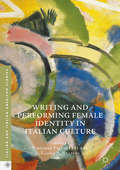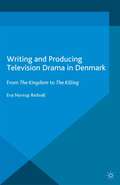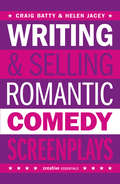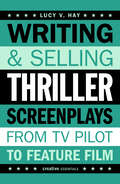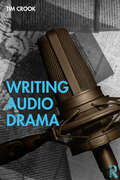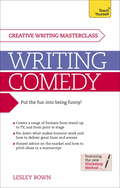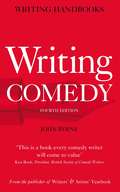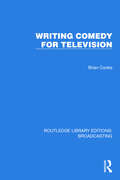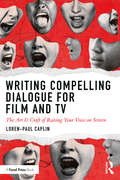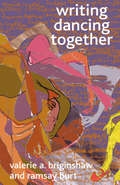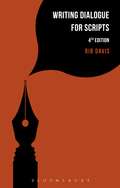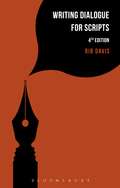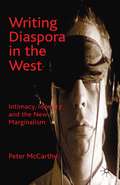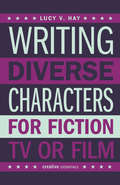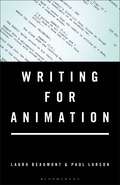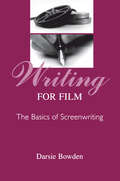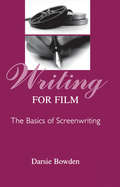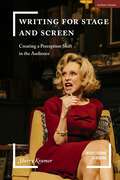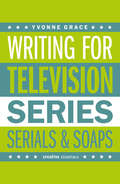- Table View
- List View
Writing and Performing Female Identity in Italian Culture
by Virginia Picchietti Laura A. SalsiniThis volume investigates the ways in which Italian women writers, filmmakers, and performers have represented female identity across genres from the immediate post-World War II period to the turn of the twenty-first century. Considering genres such as prose, poetry, drama, and film, these essays examine the vision of female agency and self-actualization arising from women artists’ critique of female identity. This dual approach reveals unique interpretations of womanhood in Italy spanning more than fifty years, while also providing a deep investigation of the manipulation of canvases historically centered on the male subject. With its unique coupling of generic and thematic concerns, the volume contributes to the ever expanding female artistic legacy, and to our understanding of postwar Italian women’s evolving relationship to the narration of history, gender roles, and these artists’ use and revision of generic convention to communicate their vision.
Writing and Producing Television Drama in Denmark: From The Kingdom to The Killing (Palgrave Studies in Screenwriting)
by Eva Novrup RedvallOffering unique insights into the writing and production of television drama series such as The Killing and Borgen, produced by DR, the Danish Broadcasting Corporation, Novrup Redvall explores the creative collaborations in writers' rooms and 'production hotels' through detailed case studies of Denmark's public service production culture.
Writing and Selling Romantic Comedy Screenplays: A Screenwriter's Guide to the RomCom Genre (Writing And Selling Screenplays Ser.)
by Helen JaceyWhat happens when ‘happy ever after’ isn’t quite so simple?Today’s attitudes to love and romance are as varied and diverse as individuals, and audiences want and need more sophisticated, authentic films that show how we live and love now. So what does this mean for the screenwriter developing a romcom? And how do they write heart-warming stories for a genre that is constantly evolving, from bromcom to zomcom to famcom?Writing and Selling Romantic Comedy Screenplays offers a fresh approach to creating narratives for this ever-changing genre. Moving away from rigid and limited definitions that have evolved out of mainstream genre films, the book embraces a working definition that crosses cultural and national boundaries to give screenwriters around the world a truly international perspective on writing comedic love stories.It is the first screenwriting guide to reflect the diversity of approaches in today’s films that deal with the human need for emotional and physical intimacy using humour – the contemporary romantic comedy.'Immensely helpful' - Divya Johry 'An excellent addition to the Creative Essentials screenwriting book family' - WritesSoFluidFeatures of the book include:Illuminating, challenging and provocative about the state of the rom-com genre. Why do some films feel so dated, while others are perennially relevant?Explores and defines all subgenres of romcom, such as zomcom, bromedy, soromcom and famcom.Uniquely draws on creativity, screenwriting genre theory and film industry practice. Stimulating creative exercises at the end of every chapter, and 'hot tips' throughout.Adaptable concepts that can be applied to both feature films and short films.Encourages screenwriters to define their own values about love to ensure their voice and message is original - and commercial.Case studies and analyses of produced screenplays, including Dostana, Due Date, I Give it a Year, I love You, Man, Midnight in Paris, Ruby Sparks, Tamara Drewe, Ted and Warm BodiesInterviews with writers, directors and producers.Genuine international perspectiveIndispensible guide for both the student and the professional writer or filmmaker.
Writing and Selling Thriller Screenplays: A Screenwriter's Guide for Film and Television (Writing And Selling Screenplays Ser.)
by Lucy V. HayWriting and Selling Thriller Screenplays has the lowdown not only on getting your thriller feature script on the page, but getting it in front of producers and investors.From premise to resolution, Lucy V. Hay guides you through the craft of thriller writing, citing classic thrillers such as Psycho, The Shining, The Sixth Sense and Fatal Attraction and lesser-known gems like Red Eye, Desperate Measures, Impostor and Deviation.The book also considers how the screenplay might be sold to investors, looking at high concept ideas, pitching, packaging and the realities of film finance.Lucy V. Hay asks: what is flight vs. fight? What is the difference between horror and thriller? What are the different sub genres of thriller? What part do actors play in film finance? How can limited locations create new opportunities in storytelling and financing? Why is the lone protagonist so in demand? Why are female characters so popular in thriller? And much, much more...'Really hones in on the specific genre of thrillers with expertise' - Write So Fluid'A must-read for any writer, producer or director looking to create (or in the process of creating) a thriller production. It could also be immensely useful for those generally curious about the genre or looking to learn more' - Film Doctor'This book should form part of the armoury for any screenplay writers bookshelf' - Stephen HallCheck out Lucy V. Hay's other screenwriting books: Writing & Selling Drama Screenplays and Writing Diverse Characters for Fiction, Film and TV
Writing Audio Drama
by Tim CrookWriting Audio Drama is a comprehensive and intelligent guide to writing sound drama for broadcasting and online production. The book uses new and original research on the history of writing radio plays in the UK and USA to explore how this has informed and developed the art form for more than 100 years. Audio drama in the context of podcasting is now experiencing a global and exponential expansion. Through analysis of examples of past and present writing, the author explains how to originate and craft drama which can explore deeply psychological and intimate themes and achieve emotional, truthful, entertaining, and thought-provoking impact. Practical analysis of the key factors required to write successful audio drama is covered in chapters focusing on audio play beginnings and openings, sound story dialogue, sustaining the sound story, plotting for sound drama and the best ways of ending audio plays. Each chapter is supported by extensive companion online resources expanding and supporting the writers and subjects discussed and explored, and extensive information on how to access online many exemplar and model sound dramas referenced in the chapters. This textbook will be an important resource for undergraduate and postgraduate students taking modules and courses on radio drama, theatre and media drama, audio theatre, audio drama, scriptwriting, media writing.
Writing Audio Drama
by Tim CrookWriting Audio Drama is a comprehensive and intelligent guide to writing sound drama for broadcasting and online production. The book uses new and original research on the history of writing radio plays in the UK and USA to explore how this has informed and developed the art form for more than 100 years. Audio drama in the context of podcasting is now experiencing a global and exponential expansion. Through analysis of examples of past and present writing, the author explains how to originate and craft drama which can explore deeply psychological and intimate themes and achieve emotional, truthful, entertaining, and thought-provoking impact. Practical analysis of the key factors required to write successful audio drama is covered in chapters focusing on audio play beginnings and openings, sound story dialogue, sustaining the sound story, plotting for sound drama and the best ways of ending audio plays. Each chapter is supported by extensive companion online resources expanding and supporting the writers and subjects discussed and explored, and extensive information on how to access online many exemplar and model sound dramas referenced in the chapters. This textbook will be an important resource for undergraduate and postgraduate students taking modules and courses on radio drama, theatre and media drama, audio theatre, audio drama, scriptwriting, media writing.
Writing Comedy: How to use funny plots and characters, wordplay and humour in your creative writing
by Lesley BownLearn how to write comedy that makes people laugh.Masterclass: Writing Comedy will reveal to both beginners and experienced writers the distinctive features that mark out comedy from other forms of creative writing. Having identified these, it will help you then to unlock your inner anarchist, and explore the different elements of comedy, using a combination of practical exercises, insight and creative inspiration. Whatever your preferred comic genre, you will find guidance on everything from wordplay and visual humour to plots, comedy characters and different styles.A section on performance will help you to hone stand-up skills, while chapters on stage and screen will give techniques and tips on how to craft a sitcom or create a sketch show. Finally, there is a uniquely frank but useful section on the realities of the markets, and the actualities of going it alone with self-publishing and self-promotion - or the tools you need to successfully pitch an idea or comic manuscript.ABOUT THE SERIESThe Teach Yourself Creative Writing series helps aspiring authors tell their stories. Covering a range of genres from science fiction and romantic novels to illustrated children's books and comedy, this series is packed with advice, exercises, and tips for unlocking creativity and improving your writing. And because we know how daunting the blank page can be, we set up the Just Write online community, at tyjustwrite.com, for budding authors and successful writers to connect and share.
Writing Comedy
by John ByrneComedy has always been one of the most high-profile, glamorous and potentially lucrative markets for scriptwriters, but it is also perceived as one of the hardest. In the fourth edition of this highly regarded handbook, John Byrne breaks down the basics of writing comedy into simple steps and shows you how to make the most of your own comedy writing talent and - just as importantly - your ability to market that talent.Here is a wealth of practical advice both on how to get your career off the ground and how to keep developing it. Whether you are writing comedy routines, sketches or sitcoms, and aiming your work at the page, the stage or the ever-expanding world of broadcasting, you will find something in this book to encourage, inform and inspire you.As with any art form, the basics of good comedy never go out of fashion. While the easy steps in this book are illustrated with examples of work by classic comedians old and new, you will also find useful advice on developing and adapting your work for the twenty-first century market, whether your aim is to promote your work online or simply to keep your gags fresh and topical in a world where the news changes by the minute and gets flashed around the world in seconds.
Writing Comedy (Writing Handbooks Ser. #41)
by John ByrneComedy has always been one of the most high-profile, glamorous and potentially lucrative markets for scriptwriters, but it is also perceived as one of the hardest. In the fourth edition of this highly regarded handbook, John Byrne breaks down the basics of writing comedy into simple steps and shows you how to make the most of your own comedy writing talent and - just as importantly - your ability to market that talent.Here is a wealth of practical advice both on how to get your career off the ground and how to keep developing it. Whether you are writing comedy routines, sketches or sitcoms, and aiming your work at the page, the stage or the ever-expanding world of broadcasting, you will find something in this book to encourage, inform and inspire you.As with any art form, the basics of good comedy never go out of fashion. While the easy steps in this book are illustrated with examples of work by classic comedians old and new, you will also find useful advice on developing and adapting your work for the twenty-first century market, whether your aim is to promote your work online or simply to keep your gags fresh and topical in a world where the news changes by the minute and gets flashed around the world in seconds.
Writing Comedy for Television (Routledge Library Editions: Broadcasting #40)
by Brian CookeWriting Comedy for Television (1983) is a practical, step-by-step manual about how and what to write. It contains many examples from the scripts of various sitcoms and sketch shows. It demonstrates how to construct a storyline for a series, how to lay out a sketch, who to pitch to, and how a television comedy is put together.
Writing Comedy for Television (Routledge Library Editions: Broadcasting #40)
by Brian CookeWriting Comedy for Television (1983) is a practical, step-by-step manual about how and what to write. It contains many examples from the scripts of various sitcoms and sketch shows. It demonstrates how to construct a storyline for a series, how to lay out a sketch, who to pitch to, and how a television comedy is put together.
Writing Compelling Dialogue for Film and TV: The Art & Craft of Raising Your Voice on Screen
by Loren-Paul CaplinWriting Compelling Dialogue for Film and TV is a practical guide that provides you, the screenwriter, with a clear set of exercises, tools, and methods to raise your ability to hear and discern conversation at a more complex level, in turn allowing you to create better, more nuanced, complex and compelling dialogue. The process of understanding dialogue writing begins with increasing writers’ awareness of what they hear. This book provides writers with an assortment of dialogue and language tools, techniques, and exercises and teaches them how to perceive and understand the function, intent and thematic/psychological elements that dialogue can convey about character, tone, and story. Text, subtext, voice, conflict, exposition, rhythm and style are among the many aspects covered. This book reminds us of the sheer joy of great dialogue and will change and enhance the way writers hear, listen to, and write dialogue, and along the way aid the writers’ confidence in their own voice allowing them to become more proficient writers of dialogue. Written by veteran screenwriter, playwright, and screenwriting professor Loren-Paul Caplin, Writing Compelling Dialogue is an invaluable writing tool for any aspiring screenwriter who wants to improve their ability to write dialogue for film and television, as well as students, professionals, and educators.
Writing Compelling Dialogue for Film and TV: The Art & Craft of Raising Your Voice on Screen
by Loren-Paul CaplinWriting Compelling Dialogue for Film and TV is a practical guide that provides you, the screenwriter, with a clear set of exercises, tools, and methods to raise your ability to hear and discern conversation at a more complex level, in turn allowing you to create better, more nuanced, complex and compelling dialogue. The process of understanding dialogue writing begins with increasing writers’ awareness of what they hear. This book provides writers with an assortment of dialogue and language tools, techniques, and exercises and teaches them how to perceive and understand the function, intent and thematic/psychological elements that dialogue can convey about character, tone, and story. Text, subtext, voice, conflict, exposition, rhythm and style are among the many aspects covered. This book reminds us of the sheer joy of great dialogue and will change and enhance the way writers hear, listen to, and write dialogue, and along the way aid the writers’ confidence in their own voice allowing them to become more proficient writers of dialogue. Written by veteran screenwriter, playwright, and screenwriting professor Loren-Paul Caplin, Writing Compelling Dialogue is an invaluable writing tool for any aspiring screenwriter who wants to improve their ability to write dialogue for film and television, as well as students, professionals, and educators.
Writing Dancing Together
by V. Briginshaw Ramsay BurtWith a political agenda foregrounding collaborative practice to promote ethical relations, these individually and joint written essays and interviews discuss dances often with visual art, theatre, film and music, drawing on continental philosophy to explore notions of space, time, identity, sensation, memory and ethics.
Writing Dialogue for Scripts (Writing Handbooks)
by Rib DavisA good story can easily be ruined by bad dialogue. Now in its 4th edition, Rib Davis's bestselling Writing Dialogue for Scripts provides expert insight into how dialogue works, what to look out for in everyday speech and how to use dialogue effectively in scripts. Examining practical examples from film, TV, theatre and radio, this book will help aspiring and professional writers alike perfect their skills. The 4th edition of Writing Dialogue for Scripts includes: a look at recent films, such as American Hustle and Blue Jasmine; TV shows such as Mad Men and Peaky Blinders; and the award winning play, Ruined. Extended material on use of narration within scripts (for example in Peep Show) and dialogue in verbatim scripts (Alecky Blythe's London Road) also features.
Writing Dialogue for Scripts (Writing Handbooks)
by Rib DavisA good story can easily be ruined by bad dialogue. Now in its 4th edition, Rib Davis's bestselling Writing Dialogue for Scripts provides expert insight into how dialogue works, what to look out for in everyday speech and how to use dialogue effectively in scripts. Examining practical examples from film, TV, theatre and radio, this book will help aspiring and professional writers alike perfect their skills. The 4th edition of Writing Dialogue for Scripts includes: a look at recent films, such as American Hustle and Blue Jasmine; TV shows such as Mad Men and Peaky Blinders; and the award winning play, Ruined. Extended material on use of narration within scripts (for example in Peep Show) and dialogue in verbatim scripts (Alecky Blythe's London Road) also features.
Writing Diaspora in the West: Intimacy, Identity and the New Marginalism
by P. McCarthyIn this bold intervention into the understanding of the diasporic experience within cultural studies, McCarthy challenges a critical position emergent over the last thirty years (what he calls the 'new marginalism'). He confronts the liberal orthodoxies that prevail in this area, exposing contradictions in the thinking of its major theorists.
Writing Diverse Characters For Fiction, TV or Film: An Essential Guide for Authors and Script Writers
by Lucy V. HayWe're living in a time of unprecedented diversity in produced media content, with more characters appearing who are Black, Asian and Minority Ethnic (BAME), Lesbian, Gay, Bisexual and Transgender (LGBT), disabled, or from other religions or classes. What's more, these characters are increasingly appearing in genre pieces, accessible to the mainstream, instead of being hidden away in so-called 'worthier' pieces, as in the past.How to Write Diverse Characters discusses issues of race, disability, sexuality and transgender people with specific reference to characterisation - not only in movies and TV, but also novel writing.Taking in blockbuster movies such as Mad Max Fury Road, Russell T Davies' ground-breaking TV series Cucumber and and the controversial novel Gone Girl, the book explores:How character role function really worksWhat is the difference between stereotype and archetype? Why 'trope' does not mean what Twitter and Tumblr think it meansHow the burden of casting affects both box office and audience perceptionWhy diversity is not about agendas, buzzwords or being 'politically correct'What authenticity truly means and why research is so importantWhy variety is key in ensuring true diversity in characterisationWriters have to catch up. Knowing not only what makes a 'good' diverse character doesn't always cut it; they need to know what agents, publishers, producers, filmmakers and commissioners are looking for - and why.This book gives writers the tools to create three dimensional, authentic characters ... who just happen to be diverse.'A timely guide to creating original characters and reinvigorating tired storylines' - Debbie Moon, creator and showrunner, Wolfblood (BBC)'Lucy V. Hay nails it' - Stephen Volk, BAFTA-winning screenwriter: Ghostwatch, Afterlife, The Awakening'Packed with practical and inspirational insights'- Karol Griffiths, development consultant and script editor, clients include ITV, BBC, Warner Brothers
Writing for Animation
by Laura Beaumont Paul LarsonAnimation is one of the fastest growing mediums in the film and television world – whether it's Frozen or Paw Patrol, Family Guy or Rick and Morty. This book is the definitive guide to storytelling for writers, directors, storyboard artists and animators. Suitable for both the student and the professional, it provides indispensable knowledge on the entire process of writing for animated movies, TV series and short films. The reader will be provided with all the tools necessary to produce professional quality scripts that will start, or further, their career in animation. Beginning with the fundamentals of 'why animation?' this book will lead the reader through a series of principles that will raise the level of their storytelling. These principles are tried and tested on a daily basis by the authors who have a twenty-year track record in the animation industry.Many people are trying to break into the world of writing for animation and a lot of the people who are 'already in' would like to get more work. The reality is that writing for animation is a very specific craft that can be learnt like any other craft. This book will give the reader both the basic and advanced techniques that will put them ahead of the rest of the field.
Writing for Animation
by Laura Beaumont Paul LarsonAnimation is one of the fastest growing mediums in the film and television world – whether it's Frozen or Paw Patrol, Family Guy or Rick and Morty. This book is the definitive guide to storytelling for writers, directors, storyboard artists and animators. Suitable for both the student and the professional, it provides indispensable knowledge on the entire process of writing for animated movies, TV series and short films. The reader will be provided with all the tools necessary to produce professional quality scripts that will start, or further, their career in animation. Beginning with the fundamentals of 'why animation?' this book will lead the reader through a series of principles that will raise the level of their storytelling. These principles are tried and tested on a daily basis by the authors who have a twenty-year track record in the animation industry.Many people are trying to break into the world of writing for animation and a lot of the people who are 'already in' would like to get more work. The reality is that writing for animation is a very specific craft that can be learnt like any other craft. This book will give the reader both the basic and advanced techniques that will put them ahead of the rest of the field.
Writing for Film: The Basics of Screenwriting
by Darsie BowdenIn this introduction to screenwriting, author Darsie Bowden provides sage, real-world advice and instruction on the process of writing film screenplays. This text will help budding screenwriters to structure their dramas, refine their characterizations, and craft their language, while also introducing them to the appropriate screenplay formats. It covers the complexities of writing for the screen and points out the contradictions to expect if readers pursue this work as a career. In addition to covering the elements of the dramatic film screenplay, Bowden discusses writing for such "alternative" markets as documentaries, independent films, experimental films, and other non-Hollywood options. Features of the text include:guidelines for working as a screenwriter;applications and exercises to enhance skills;suggested readings for further development; anda comprehensive list of resources for screenwriting.Successful writing for film lies in being able to heighten one's perceptive abilities about the world and to communicate those perceptions in a cinematic way. In this text, Bowden introduces readers to an approach to screenwriting that will help them see the world in a different way and write about it using different genres and media. This most valuable skill prepares readers for the range of possibilities they will encounter on the path to successful screenwriting.
Writing for Film: The Basics of Screenwriting
by Darsie BowdenIn this introduction to screenwriting, author Darsie Bowden provides sage, real-world advice and instruction on the process of writing film screenplays. This text will help budding screenwriters to structure their dramas, refine their characterizations, and craft their language, while also introducing them to the appropriate screenplay formats. It covers the complexities of writing for the screen and points out the contradictions to expect if readers pursue this work as a career. In addition to covering the elements of the dramatic film screenplay, Bowden discusses writing for such "alternative" markets as documentaries, independent films, experimental films, and other non-Hollywood options. Features of the text include:guidelines for working as a screenwriter;applications and exercises to enhance skills;suggested readings for further development; anda comprehensive list of resources for screenwriting.Successful writing for film lies in being able to heighten one's perceptive abilities about the world and to communicate those perceptions in a cinematic way. In this text, Bowden introduces readers to an approach to screenwriting that will help them see the world in a different way and write about it using different genres and media. This most valuable skill prepares readers for the range of possibilities they will encounter on the path to successful screenwriting.
Writing for Film: The Basics of Screenwriting
by Darsie BowdenIn this introduction to screenwriting, author Darsie Bowden provides sage, real-world advice and instruction on the process of writing film screenplays. This text will help budding screenwriters to structure their dramas, refine their characterizations, and craft their language, while also introducing them to the appropriate screenplay formats. It covers the complexities of writing for the screen and points out the contradictions to expect if readers pursue this work as a career. In addition to covering the elements of the dramatic film screenplay, Bowden discusses writing for such "alternative" markets as documentaries, independent films, experimental films, and other non-Hollywood options. Features of the text include:guidelines for working as a screenwriter;applications and exercises to enhance skills;suggested readings for further development; anda comprehensive list of resources for screenwriting.Successful writing for film lies in being able to heighten one's perceptive abilities about the world and to communicate those perceptions in a cinematic way. In this text, Bowden introduces readers to an approach to screenwriting that will help them see the world in a different way and write about it using different genres and media. This most valuable skill prepares readers for the range of possibilities they will encounter on the path to successful screenwriting.
Writing for Stage and Screen: Creating a Perception Shift in the Audience (Introductions to Theatre)
by Sherry Kramer"This book does what no other playwriting book in my experience has done, it offers a new way of seeing and conceiving how theatre makes meaning and carries emotional impact in performance."Suzan Zeder, Professor Emerita and former Head Of Playwriting at University of Texas at Austin, USACombining a step-by-step analysis of the technique of writing for stage and screen with how the mystery, poetry, and emotional momentum is achieved for the audience, Sherry Kramer offers an empowering, original guide for emerging and established writers. In this structured look at the way audience members progress through a work in real time, Sherry Kramer uses plain-spoken vocabulary to help you discover how to make work that will mean more to your audiences. By using examples drawn from plays, film, and streaming series, ranging from A Streetcar Named Desire to Fleabag to Pirates of the Caribbean, this study makes its concepts accessible to a wide range of artists who work in timebound art. The book also features multiple exercises, developed with MFA writers in The Iowa Playwrights Workshop and The Michener Center for Writers, where Kramer taught for the past 25 years, which provide entrance points to help you consider and create your work.
Writing for Television: A Complete Writer's Guide to Series, Serials and Soaps
by Yvonne GraceA no-nonsense, direct down-the-lens look at the television industry written from the point of view of a television drama producer who's been there, done it, fought some battles and won the odd award. Written in an engaging, anecdotal tone, Writing for Television provides advice on:Getting an agentThe type of writer television's looking forThe tool kit a television writer needsThe writer/script editor relationshipHow to structure a storylineHow to write good treatments and outlinesPacked full of useful insights, links and information, the book includes interviews with successful television writers working today, pointers on how to work collaboratively in the industry and how to make good contacts with the people who can further your career.'Yvonne delivers a practical, accessible, no-nonsense guide to the world of writing for popular TV' - Mal Young, Producer, writer and former BBC Controller of Drama Series'A very comprehensive and informative book on TV script writing. Yvonne covers every conceivable point that will help writers wanting to break into writing for the small screen, whilst at the same time creating a very accessible read' - Tony McHale, Sanctuary Films
